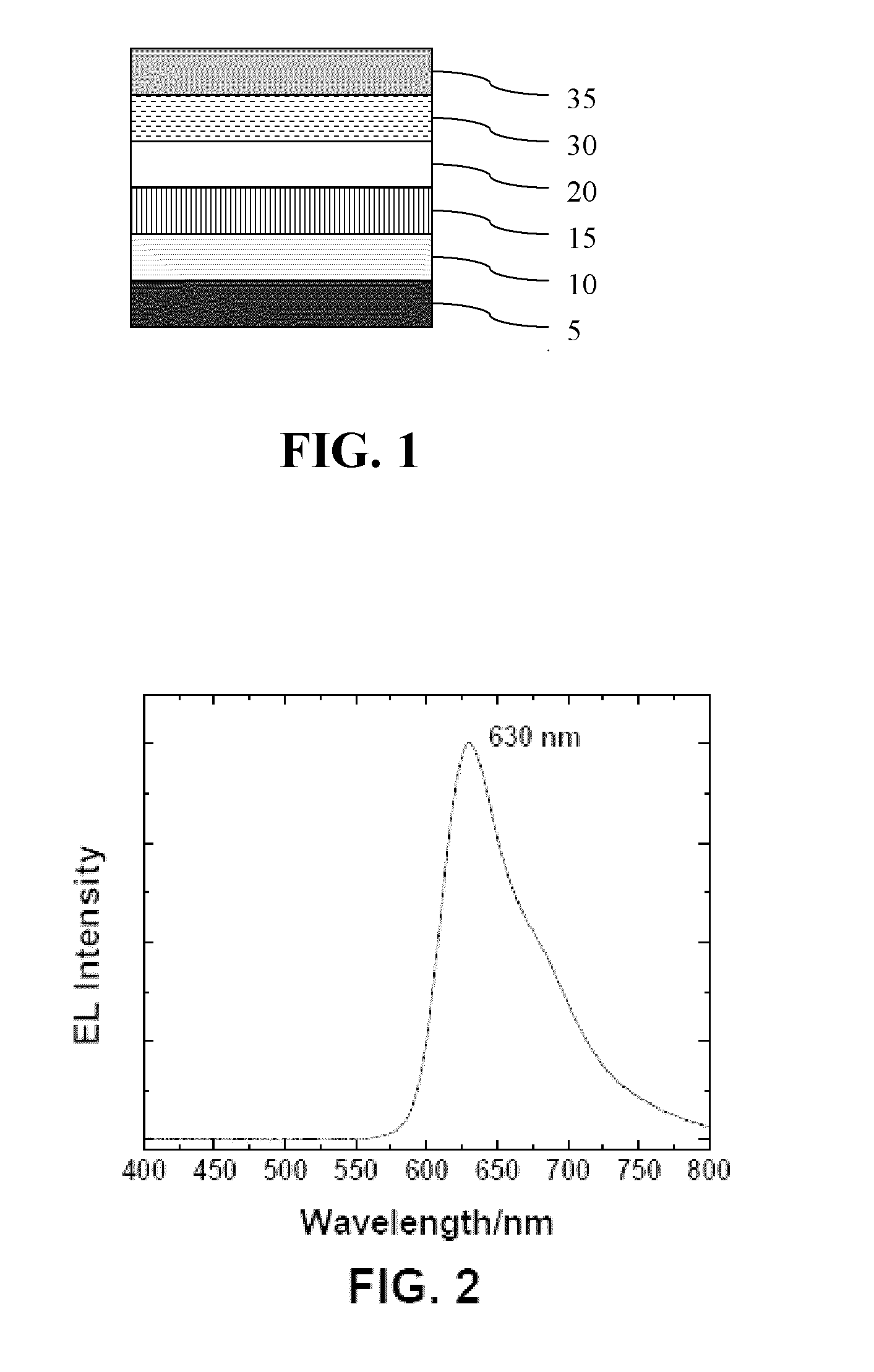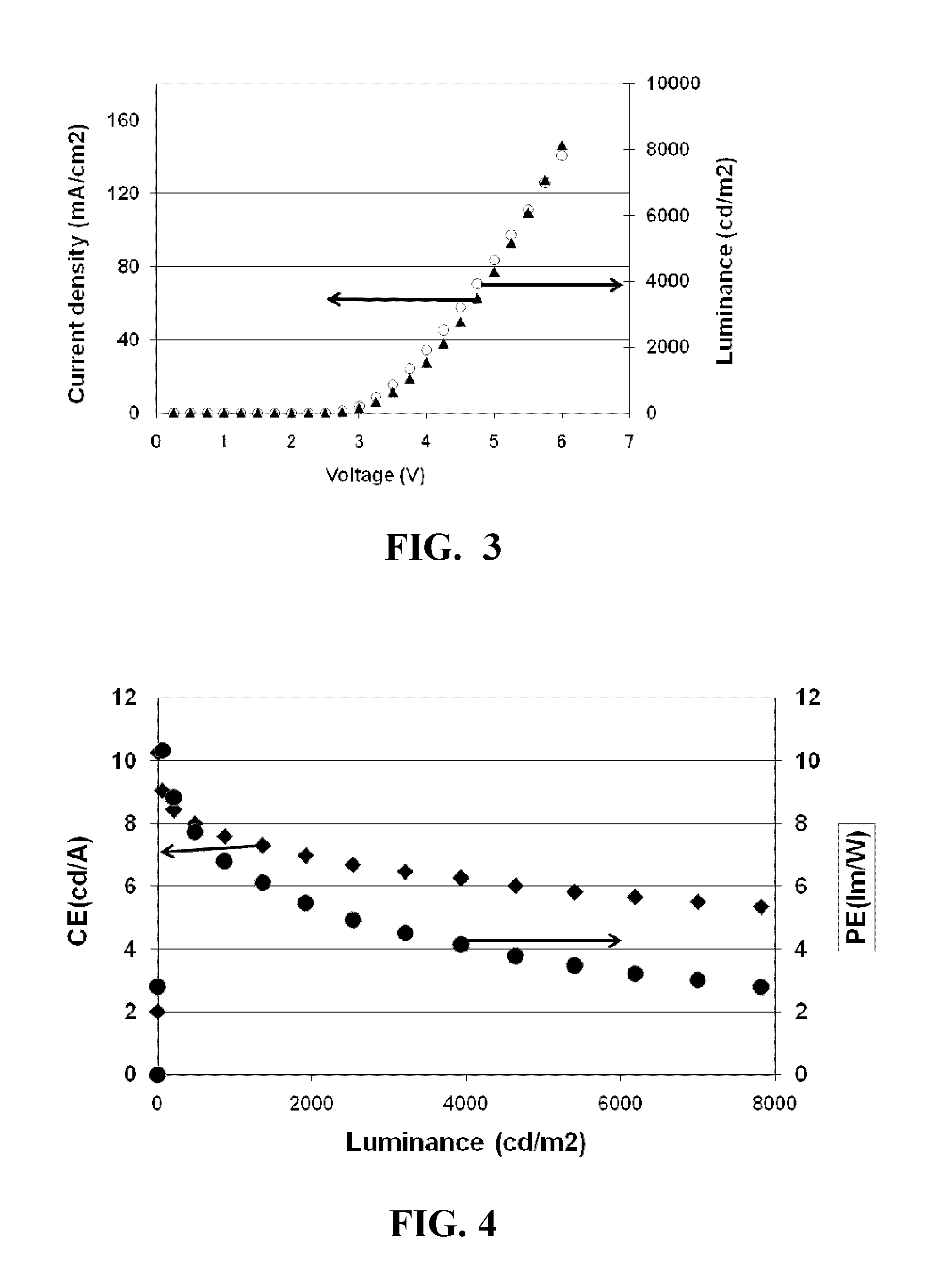Polyphenylene host compounds
a technology of host compounds and polyphenylene, which is applied in the field of lightemitting layer host compounds, can solve the problems of low stability, high charge injection barrier, imbalanced charge injection and mobility,
- Summary
- Abstract
- Description
- Claims
- Application Information
AI Technical Summary
Benefits of technology
Problems solved by technology
Method used
Image
Examples
example 1.1
Example 1.1.1
4-Bromo-N-(2-(phenylamino)phenyl)benzamide (1): To a solution of 4-bromo-benzoyl chloride (11 g, 50 mmol) in anhydrous dichloromethane (DCM) (100 ml), was added N-phenylbenzene-1,2-diamine (10.2 g, 55 mmol), then triethylamine (TEA) (17 ml, 122 mmol) slowly. The whole was stirred at room temperature (RT) overnight. Filtration gave a white solid 1 (6.5 g). The filtrate was worked up with water (300 ml), then extracted with DCM (300 ml) three times. The organic phase was collected and dried over MgSO4, concentrated and recrystallized in DCM / hexanes to give another portion of white solid 1 (10.6 g). Total amount of product 1 is 17.1 g, in 93% yield.
example 1.1.2
2-(4-bromophenyl)-1-phenyl-1H-benzo[d]imidazole (2): To a suspension of amide 1 (9.6 g, 26 mmol) in anhydrous 1,4-dioxane (100 mL) was added phosphorus oxychloride (POCl3) (9.2 mL, 100 mmol) slowly. The whole was then heated at 100° C. overnight. After cooling to RT, the mixture was poured into ice (200 g) with stirring. Filtration, followed by recrystallization in DCM / hexanes gave a pale grey solid 2 (8.2 g, in 90% yield).
Example 1.1.3
1-phenyl-2-(4-(4,4,5,5-tetramethyl-1,3,2-dioxaborolan-2-yl)phenyl)-1H-benzo[d]imidazole (3): A mixture of Compound 2 (0.70 g, 2 mmol), bis(pinacolate)diborane (0.533 g, 2.1 mmol), bis(diphenylphosphino)ferrocene]dichloropalladium (Pd(dppf)Cl2) (0.060 g, 0.08 mmol) and anhydrous potassium acetate (KOAc) (0.393 g, 4 mmol) in 1,4-dioxane (20 ml) was heated at 80° C. under argon overnight. After cooling to RT, the whole was diluted with ethyl acetate (80 ml) then filtered. The solution was absorbed on silica gel, then purified by column chromatography (he...
example 1.1.3
2-(4′-bromo-[1,1′-biphenyl]-4-yl)-1-phenyl-1H-benzo[d]imidazole (4): A mixture of compound 3 (4.01 g, 10.1 mmol), 1-bromo-4-iodobenzene (5.73 g, 20.2 mmol), Pd(PPh3)4 (0.58 g, 0.5 mmol) and potassium carbonate (4.2 g, 30 mmol) in dioxane / water (60 ml / 10 ml) was degassed and heated at 95° C. overnight. After being cooled to RT, the mixture was poured into ethyl acetate (250 ml), washed with brine, dried over Na2SO4, then loaded on silica gel, purified by flash column (hexanes to hexanes / ethyl acetate 4:1) to give a light yellow solid washed with methanol and dried in air (3.39 g, in 80% yield).
PUM
| Property | Measurement | Unit |
|---|---|---|
| Luminance | aaaaa | aaaaa |
| Luminance | aaaaa | aaaaa |
| Luminance | aaaaa | aaaaa |
Abstract
Description
Claims
Application Information
 Login to View More
Login to View More - R&D
- Intellectual Property
- Life Sciences
- Materials
- Tech Scout
- Unparalleled Data Quality
- Higher Quality Content
- 60% Fewer Hallucinations
Browse by: Latest US Patents, China's latest patents, Technical Efficacy Thesaurus, Application Domain, Technology Topic, Popular Technical Reports.
© 2025 PatSnap. All rights reserved.Legal|Privacy policy|Modern Slavery Act Transparency Statement|Sitemap|About US| Contact US: help@patsnap.com



